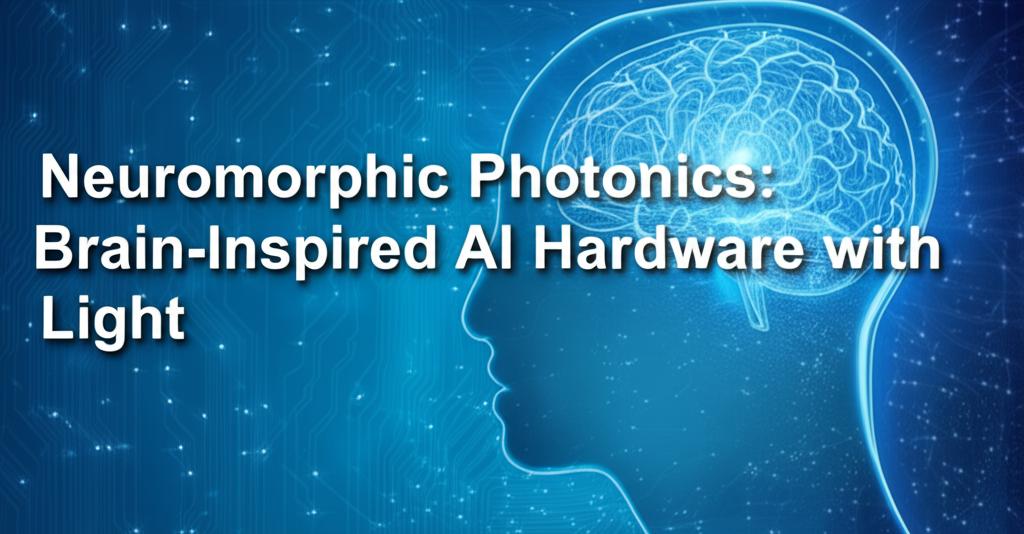The Dawn of Light-Speed AI: How Brain-Inspired Photonics is Revolutionizing Artificial Intelligence
Imagine computers that think like a human brain, processing information at the speed of light. This isn't science fiction anymore; it's the rapidly unfolding reality of neuromorphic photonics. This groundbreaking field is merging the intricate architecture of our brains with the incredible speed and efficiency of light to create a new generation of artificial intelligence hardware. The promise? AI systems that are faster, more powerful, and significantly more energy-efficient than ever before.
For decades, AI advancements have been largely fueled by improvements in traditional silicon-based electronics. However, as AI models become increasingly complex, they demand computational power and energy that are pushing the limits of current technology. This is where neuromorphic photonics steps in, offering a paradigm shift. Instead of relying solely on electrons, it harnesses photons – particles of light – to perform computations.
Why Light? The Photonic AdvantageLight offers several inherent advantages for AI. Photonic circuits can transmit data at significantly higher bandwidths and with lower energy loss compared to their electronic counterparts. This means faster processing speeds and a dramatic reduction in the energy footprint of AI operations – a critical factor as AI applications become more widespread.
Furthermore, the way light interacts with certain materials allows for the creation of components that inherently mimic the behavior of neurons and synapses in the human brain. These "photonic neurons" and "photonic synapses" can be interconnected to form neural networks that learn and process information in a way that is remarkably similar to how our own brains work. This brain-inspired approach, known as neuromorphic computing, allows for highly parallel processing, making it exceptionally well-suited for complex AI tasks like pattern recognition, natural language processing, and real-time decision-making.
Recent Breakthroughs Illuminating the Path ForwardThe field of neuromorphic photonics is buzzing with exciting developments. Researchers are making significant strides in:
- Developing Novel Photonic Materials and Devices: Scientists are engineering new materials and miniaturized photonic components that can be integrated onto chips, paving the way for compact and scalable neuromorphic processors. These include advanced optical modulators, photodetectors, and on-chip lasers.
- Designing Brain-Inspired Architectures: New architectures for photonic neural networks are emerging, drawing inspiration from the complex connectivity and plasticity of the human brain. These designs aim to replicate the brain's ability to learn and adapt efficiently.
- Demonstrating Real-World Applications: We are seeing increasingly sophisticated demonstrations of neuromorphic photonics in action. This includes ultra-fast image and speech recognition, high-speed data analysis for scientific discovery, and even the development of more intuitive and responsive robotic systems.
- Hybrid Approaches: Many researchers are exploring hybrid optoelectronic systems that combine the strengths of both photonics and electronics to create even more powerful and versatile AI hardware.
Neuromorphic photonics stands at the forefront of a new era in artificial intelligence. By emulating the brain's computational prowess with the speed and efficiency of light, this technology holds the key to unlocking unprecedented AI capabilities. From enabling more sophisticated autonomous systems and accelerating drug discovery to revolutionizing data centers and creating truly intelligent personal assistants, the potential applications are vast and transformative.
While challenges in manufacturing, scalability, and programming these novel photonic systems still exist, the rapid pace of innovation is undeniable. As research continues to illuminate the path forward, neuromorphic photonics is poised to redefine the boundaries of what's possible in artificial intelligence, ushering in a future where AI operates quite literally at the speed of thought. The age of light-speed, brain-inspired AI is no longer a distant dream; it's an exciting reality taking shape before our very eyes.

